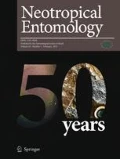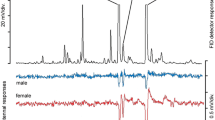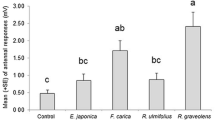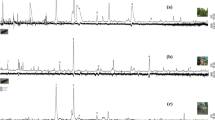Abstract
The potato tuberworm moth (PTM) Phthorimaea operculella (Zeller) (Lepidoptera: Gelechiidae) is one of the most damaging pests of potato Solanum tuberosum L. in warm temperate and subtropical areas. Our previous experiment showed that extracts of larval frass of PTM deterred oviposition of conspecific females. In this study, we investigated the identification of chemicals in larval frass that were influencing the oviposition of PTM by behavioral bioassays and electroantennography analysis in the laboratory. Frass was collected from third and fourth instar larvae and combined analysis of gas chromatography coupled with electroantennography (GC-EAD) of dichloromethane extracts showed that eight compounds from larval frass extracts elicited repeatable antennal responses from mated females. Seven EAD-active compounds in frass volatile extract were identified by gas chromatography-mass spectrometry (GC-MS) as linoleic acid, octadecanoic acid, tricosane, pentacosane, heptacosane, nonacosane, and cholesterol. Oviposition bioassays indicated that frass extracts had a deterrent effect on egg laying, the deterrent activity increased with the concentration of frass extracts, and the threshold value for statistical significance in oviposition deterrence was in the range of 20–200 mg frass per cage. Linoleic acid, pentacosane, heptacosane, nonacosane, and cholesterol in larval frass volatiles were found to play a key role in repelling oviposition in a dose-dependent manner. We suggest that the bioactive compounds in larval frass are responsible for repelling oviposition of PTM, and n-alkanes, especially pentacosane, strongly deter oviposition and may be considered as a potential oviposition deterrent for potential applications.



Similar content being viewed by others
References
Ahmed AAI, Hashem MY, Adel MM, Mohamed SM, Khalil SS (2013a) Impact of Spodoptera littoralis (Boisd.) and Agrotis ipsilon (Hufn.) larval frass on oviposition of conspecific insects. Arch Phytopathol Plant Protect 46:575–592
Ahmed AAI, Hashem MY, Mohamed SM, Khalil SS (2013b) Protection of potato crop against Phthorimaea operculella (Zeller) infestation using frass extract of two noctuid insect pests under laboratory and storage simulation conditions. Arch Phytopathol Plant Protect 46:2409–2419
Ahmed AAI, Hashem MY, El-Shershaby MM, Khalil SS (2015) Impact of ethanolic extract of Spodoptera littoralis (Boisd.) larval frass on oviposition deterrent of Phthorimaea operculella (Zeller) adult females. Egypt J Biol Pest Co 25:51–55
Anderson P, LöFqvist J (1996) Oviposition deterrents from potato, wheat germ, larval frass, and artificial diet for Agrotis segetum (Lepidoptera: Noctuidae). Environ Entomol 25:653–658
Anderson P, Hilker M, Hansson BS, Bombosch S, Klein B, Schildknecht H (1993) Oviposition deterring components in larval frass of Spodoptera littoralis (Boisd) (Lepidoptera: Noctuidae): a behavioural and electrophysiological evaluation. J Insect Physiol 39:129–137
Behmer ST, Nes D (2003) Insect sterol nutrition and physiology: a global overview. In: Advances in insect physiology. Elsevier, Oxford, pp 1–72
Chen G, Wang ZW, Wen P, Wei W, Chen Y, Ai H, Sun WB (2018) Hydrocarbons mediate seed dispersal: a new mechanism of vespicochory. New Phytol 220:714–725. https://doi.org/10.1111/nph.15166
Coll M, Gavish S, Dori I (2000) Population biology of the potato tuber moth, Phthorimaea operculella (Lepidoptera: Gelechiidae), in two potato cropping systems in Israel. Bull Entomol Res 90:309–315
Ditrick LE, Jones RL, Chiang HC (1983) An oviposition deterrent for the European corn borer, Ostrinia nubilalis (Lepidoptera: Pyralidae), extracted from larval frass. J Insect Physiol 29:119–121
Eigenbrode SD, Espelie KE (1995) Effects of plant epicuticular lipids on insect herbivores. Annu Rev Entomol 40:171–194
Espelie KE, Bernays EA, Brown JJ (1991) Plant and insect cuticular lipids serve as behavioral cues for insects. Arch Insect Biochem Physiol 17:223–233
Gui FR, Li ZY (2003) A method for rearing the potato tuber moth Phthorimaea operculella on potato. Entomol Knowl 40:187–189
Guo L, Li GQ (2009) Olfactory perception of oviposition-deterring fatty acids and their methyl esters by the Asian corn borer, Ostrinia furnacalis. J Insect Sci 9(67):1–9
Hilker M, Klein B (1989) Investigation of oviposition deterrent in the larval frass of Spodoptera littoralis (Boisd). J Chem Ecol 15:929–938
Howard RW, Blomquist GJ (2005) Ecological, behavioral, and biochemical aspects of insect hydrocarbons. Annu Rev Entomol 50:371–393
Jouni ZE, Zamora J, Wells MA (2002) Absorption and tissue distribution of cholesterol in Manduca sexta. Arch Insect Biochem Physiol 49:167–175
Katsoyannos BI, Boller EF (1976) First field application of oviposition-deterring marking pheromone of European cherry fruit fly. Environ Entomol 5:151–152
Kroschel J, Schaub B (2013) Biology and ecology of potato tuber moths as major pests of potato. In: Giordanengo P, Vincent C, Alyokhin A (eds) Insect pests of potato: global perspectives on biology and management. Elsevier, Oxford, pp 165–192
Li G, Ishikawa Y (2004) Oviposition deterrents in larval frass of four Ostrinia species fed on an artificial diet. J Chem Ecol 30:1445–1456
Li GQ, Han ZJ, Mu LL, Qin XR, Chen CK, Wang YC (2001) Natural oviposition deterring chemicals in female cotton bollworm, Helicoverpa armigera (Hübner). J Insect Physiol 47:951–956
Ma YF, Xiao C (2013) Push-pull effects of three plant secondary metabolites on oviposition of the potato tuber moth, Phtorimaea operculella. J Insect Sci 13(128):1–7
Mant J, Brändli C, Vereecken NJ, Schulz CM, Francke W, Schiestl FP (2005) Cuticular hydrocarbons as sex pheromone of the bee Colletes cunicularius and the key to its mimicry by the sexually deceptive orchid, Ophrys exaltata. J Chem Ecol 31:1765–1787
Molnár BP, Tóth Z, Kárpáti Z (2017) Synthetic blend of larval frass volatiles repel oviposition in the invasive box tree moth, Cydalima perspectalis. J Pest Sci 90:873–885
Mudd A, Ferguson AW, Blight MM, Williams IH, Scubla P, Solinas M, Clark SJ (1997) Extraction, isolation, and composition of oviposition-deterring secretion of cabbage seed weevil Ceutorhynchus assimilis. J Chem Ecol 23:2227–2240
Ozaki M, Wada-Katsumata A (2010) Perception and olfactionof cuticular compounds. In: Blomquist GJ, Bagneres AG (eds) Insect Hydrocarbons; biology, bio-chemistry, and chemical Ecology. Cambridge University Press, Cambridge, pp 207–221
Puri SN, Mendki MJ, Sukumaran D, Ganesan K, Prakash S, Sekhar K (2006) Electroantennogram and behavioral responses of Culex quinquefasciatus (Diptera: Culicidae) females to chemicals found in human skin emanations. J Med Entomol 43:207–213
Ren JT, Hu CH, Wang X, Xiao C (2007) Deterrent effect of larval frass extracts on female potato tuberworm Phthorimaea operculella. Acta Agric Jiangxi 19:77–78
Renwick JAA (1989) Chemical ecology of oviposition in phytophagous insects. Experientia 45:223–228
Renwick JAA, Radke CD (1980) An oviposition deterrent associated with frass from feeding larvae of the cabbage looper, Trichoplusia ni (Lepidoptera: Noctuidae). Environ Entomol 9:318–320
Rhainds M, Gries G, Morales JL (1996) Oviposition deterrency in pineapple borer females, Thecia basilides (Lepidoptera: Lycaenidae). Ecol Entomol 21:105–106
Rondon SI (2010) The potato tuberworm: a literature review of its biology, ecology, and control. Am J Potato Res 87:149–166
Sarkar N, Mukherjee A, Bari A (2013) Long-chain alkanes: allelochemicals for host location by the insect pest, Epilachna dodecastigma (Coleoptera: Coccinellidae). Appl Entomol Zool 48:171–179
Thompson BM, Grebenok RJ, Behmer ST, Gruner DS (2013) Microbial symbionts shape the sterol profile of the xylem-feeding woodwasp, Sirex noctilio. J Chem Ecol 39:129–139
Udayagiri S, Mason CE (1997) Epicuticular wax chemicals in Zea mays influence oviposition in Ostrinia nubilalis. J Chem Ecol 23:1675–1687
Williams AL, Mitchell ER, Heath RR, Barfield CS (1986) Oviposition deterrents for fall armyworm (Lepidoptera: Noctuidae) from larval frass, corn leaves, and artificial diet. Environ Entomol 15:327–330
Xu HY, Li GQ, Liu ML, Xing GN (2006) Oviposition deterrents in larval frass of the cotton boll worm, Helicoverpa armigera (Lepidoptera: Noctuidae): chemical identification and electroantennography analysis. J Insect Physiol 52:320–326
Acknowledgments
We are grateful to Zhen Yu (Kunming Institute of Botany, Chinese Academy of Sciences) for technical analysis of the compounds of larval frass extracts using GC-MS. We also thank Xiaojiao Zhang, Yang Li, and Xingyong Zhou for their help with collecting and rearing the insects.
Funding
This research was funded by the National Natural Science Foundation of China (31560607).
Author information
Authors and Affiliations
Contributions
WXD, CX and YLG conceived the study. XGZ, XL, and YL performed experiments. XGZ and XL conducted data analyses. XGZ wrote the paper.
Corresponding author
Additional information
Edited by Eugenio E de Oliveira – UFV
Publisher’s Note
Springer Nature remains neutral with regard to jurisdictional claims in published maps and institutional affiliations.
Rights and permissions
About this article
Cite this article
Zhang, X.G., Li, X., Gao, Y.L. et al. Oviposition Deterrents in Larval Frass of Potato Tuberworm Moth, Phthorimaea operculella (Lepidoptera: Gelechiidae). Neotrop Entomol 48, 496–502 (2019). https://doi.org/10.1007/s13744-018-0655-y
Received:
Accepted:
Published:
Issue Date:
DOI: https://doi.org/10.1007/s13744-018-0655-y




